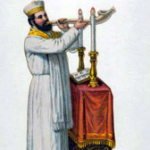Three types of sermon – Rosh HaShanah
 Isaac Abravanel applied the three shofar notes – t’ki’ah, t’ru’ah and sh’varim – to rabbinic discourses or sermons.
Isaac Abravanel applied the three shofar notes – t’ki’ah, t’ru’ah and sh’varim – to rabbinic discourses or sermons.
The t’ki’ah sermon is clear, straightforward and often provocative. The t’ru’ah sermon is intricate and allusive. The sh’varim sermon has three sections, makes (usually) three points and does not stray from its overall theme.
Histories of Jewish preaching – beginning even before the onset of the Midrash – indicate how discourses over the ages have tended to fit into one of these styles. What has really changed, however, is the content of the discourses.
The Emancipation radically affected the rabbi, moving him away from Talmudic expositions to more contemporary themes. The more modern the rabbi, the more contemporary was the sermon. The more traditional the rabbi, the more attention he paid to traditional rabbinic sources.
In recent decades, the Modern Orthodox movement has tended to return to halachic studies asking how contemporary themes can best be looked out through a halachic lens.



